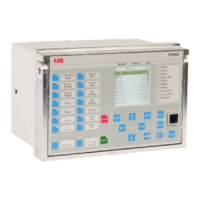Section 5 1MAC309294-MB F
Control functions
338 RER620
Technical Manual
the Sectionalizing recloser, the Sectionalizing recloser will open after a program delay to
set up for the back feeding from the alternate source. This timer is set to expire prior to the
Midpoint and Tiepoint timers.
5.4.3.2 Midpoint Recloser
The Midpoint recloser also is normally closed. Unlike the Sectionalizing recloser,
however, it does not open in response to phase voltage loss. Instead, it supports loop
control by automatically altering the RER620 settings in accordance with changing
voltage conditions. Specifically, upon the expiration of it's under voltage timer, it will
switch to a new setting group to prepare for a back feed condition and for a period will go
into non-reclose mode. The reason for the nonreclose is that in the event the fault is
between the Sectionalizing unit and the Midpoint, it would be undesirable to have the
recloser sequence through multiple operations. Though the reclose blocked condition will
change to normal after a programmed amount of time, the control will stay in New Settings
Group until the loop scheme is reset.
5.4.3.3 Tiepoint Recloser
The Tiepoint recloser, unlike the Sectionalizing and Midpoint recloser is normally open.
It closes in response to a loss of all phase voltages from one source if the other source phase
voltages are live. Once closed, the Tiepoint breaker will trip automatically if a downstream
overcurrent condition exists and is not isolated by the midpoint recloser first. The Tiepoint
recloser can be set to employ different fault thresholds depending on which side of the loop
it is supplying, i.e., which side is downstream. After the close operation, it also is set to go
into non-reclose mode for a period of time in the event the fault is between the Midpoint
and Tiepoint. If the control changed to New Settings Group for the close operation, it will
remain in that setting group until the Recloser is opened and the loop scheme is reset.
5.4.4 Operation principle
The Operation setting is used to enable or disable the function. When selected “On” the
function is enabled and respectively “Off” means function is disabled.
The operation of DLCM can be described by using a module diagram (see Figure 179). All
the modules in the diagram are explained in the next sections.

